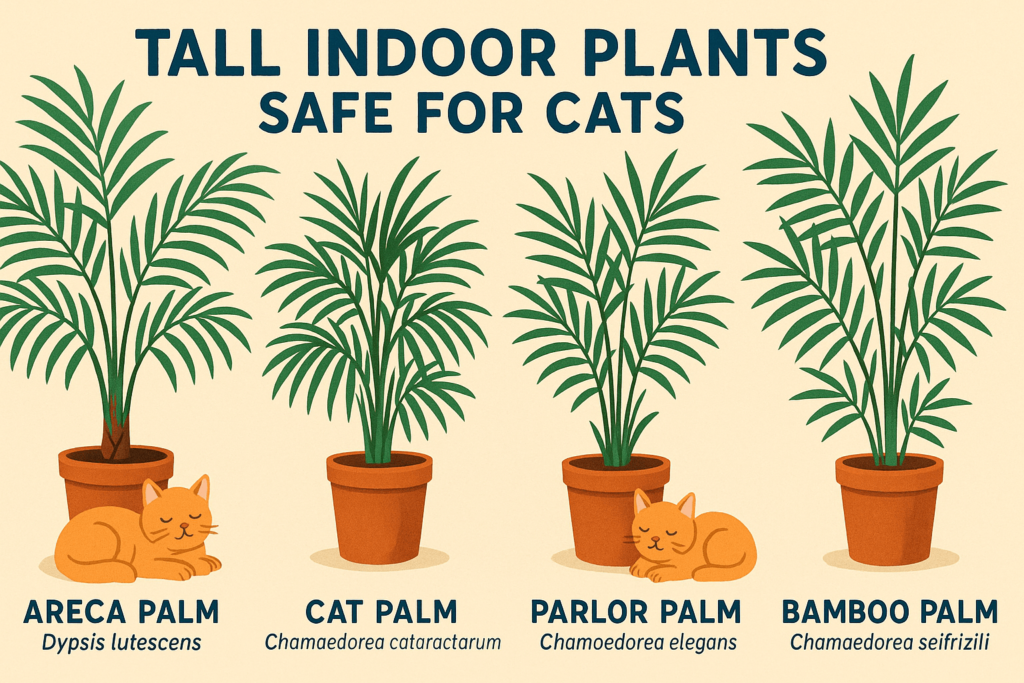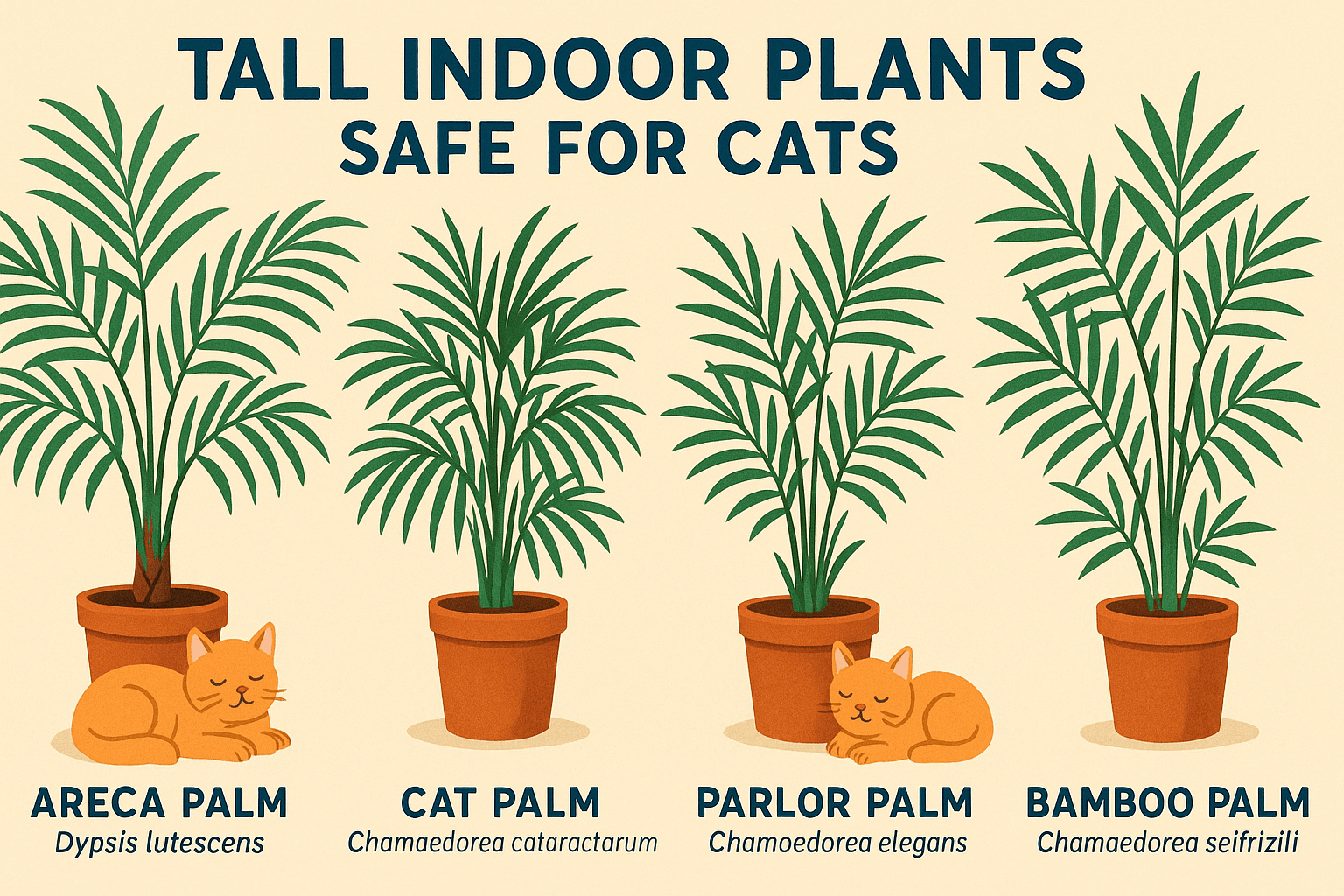Tall Indoor Plants Safe for Cats
Bringing tall indoor plants into your home can add a touch of greenery and elegance, but if you share your space with a curious feline, it’s essential to choose plants that are safe for cats. Cats are naturally drawn to nibbling on leaves, which can sometimes lead to accidental ingestion of toxic substances. Fortunately, there are plenty of tall, cat-friendly plants that not only enhance your decor but also ensure your furry friend stays safe. In this guide, we’ll explore the best tall indoor plants that are non-toxic to cats, tips for incorporating them into your home, and how to create a harmonious environment for both your plants and your pet.
Expert Insight: The Unique Risks of Plants for Cats
“It’s also important for cat parents to know that some plants and flowers that are relatively safe for dogs can be deadly for cats. For example, lilies can cause kidney failure in cats, but only mild stomach upset in dogs. So don’t assume the same rules apply for your dog-friendly plants.”
Best Tall Indoor Plants Safe for Cats
When selecting tall plants for your home, it’s crucial to prioritize species that are non-toxic and safe for your feline companions. These options are perfect for adding height and beauty to your space without compromising your cat’s health.
Areca Palm (Dypsis lutescens):
This elegant palm is not only safe for cats but also helps purify the air, making it a functional addition to any room.Parlor Palm (Chamaedorea elegans):
A low-maintenance plant that thrives in indirect light, the parlor palm is a favorite among cat owners for its pet-safe qualities.Boston Fern (Nephrolepis exaltata):
With its lush, cascading fronds, the Boston fern adds a touch of drama while being completely harmless to curious cats.Calathea (Calathea spp.):
Known for its striking patterns, the calathea is a non-toxic option that can grow tall and vibrant under the right conditions.Spider Plant (Chlorophytum comosum):
Though not always tall, spider plants can grow long, arching leaves and are incredibly resilient and safe for cats.
These tall indoor plants offer a perfect balance of aesthetics and safety, ensuring your home remains both beautiful and pet-friendly.

Tips for Incorporating Tall Plants Into Your Home Safely
Adding tall plants to your home requires thoughtful placement and care to ensure they coexist harmoniously with your cat. Follow these tips to create a safe and stylish environment.
Choose Sturdy Pots:
Opt for heavy or wide-based pots to prevent your cat from knocking over tall plants during play.Place Plants Out of Reach:
Position tall plants on shelves or elevated surfaces where your cat can admire them but not chew on them excessively.Use Hanging Planters:
Hanging planters are an excellent way to display tall plants like Boston ferns without risking your cat’s access.Monitor Curiosity Levels:
Keep an eye on your cat’s behavior around new plants to ensure they don’t develop a habit of chewing on leaves.Avoid Toxic Decorative Items:
When decorating around your plants, avoid using items like artificial moss or fertilizers that could be harmful if ingested.
By following these guidelines, you can enjoy the beauty of tall plants while keeping your cat safe and content.
Check this guide 👉Is Gladiolus Cat Safe? Best 7 Expert Tips!
Check this guide 👉Is Anthurium Safe for Cats? Best 7 Expert Tips!
Check this guide 👉Is Ranunculus Cat Safe? Best 7 Expert Tips!
Safe Tall Plants for Cats | Toxic Plants to Avoid |
|---|---|
Areca Palm | Dieffenbachia |
Parlor Palm | Sago Palm |
Boston Fern | Philodendron |
Calathea | Peace Lily |
Spider Plant | Aloe Vera |
How to Care for Tall Cat-Safe Plants
Proper care ensures your tall indoor plants thrive and remain a safe addition to your home. Here’s how to maintain them effectively while keeping your cat in mind.
Provide Adequate Light:
Most tall plants, like the areca palm and calathea, require bright, indirect light to grow healthy and strong.Water Consistently but Sparingly:
Overwatering can harm both your plants and your cat if mold develops. Stick to a watering schedule based on each plant’s needs.Clean Leaves Regularly:
Dust can accumulate on tall plant leaves, affecting their appearance and health. Wipe them gently with a damp cloth.Check for Pests:
Inspect your plants regularly for signs of pests, which can spread quickly and pose risks to pets if left untreated.Rotate Plants Occasionally:
Rotating your plants ensures even growth and prevents them from leaning toward light sources excessively.
With proper care, your tall plants will flourish and continue to enhance your home safely.
Creative Ways to Display Tall Plants Safely
Incorporating tall plants into your home doesn’t have to compromise safety. These creative ideas allow you to showcase your greenery while protecting your cat.
Vertical Gardens:
Install a vertical garden on a wall to keep plants elevated and out of reach while adding visual interest.Corner Displays:
Use corners of rooms to place tall plants, ensuring they’re less accessible to curious cats.Cat-Friendly Plant Stands:
Invest in sturdy, elevated stands designed to support tall plants securely.Room Dividers with Built-In Shelves:
These multi-functional pieces provide space for plants while creating separation in shared areas.Cat-Proof Plant Rooms:
Dedicate a specific room or area for your plants, using baby gates or barriers to limit your cat’s access.
These solutions blend functionality and creativity, allowing you to enjoy tall plants without worry.
Signs Your Cat May Be Interested in Your Plants
Cats are naturally curious creatures, and their fascination with plants can range from harmless curiosity to potentially problematic behavior. Recognizing these signs early can help you take preventive measures.
Chewing on Leaves:
If your cat frequently chews on plant leaves, it may indicate boredom or a desire for greens. Offer cat-safe grass as an alternative.Knocking Over Pots:
Cats love to swat at objects, and lightweight pots are easy targets. Secure your plants to avoid accidents.Hiding Near Plants:
Some cats enjoy lounging near tall plants for shade or privacy. Ensure the area is safe and free of hazards.Digging in Soil:
Cats may dig in plant soil out of curiosity or to use it as a litter box. Cover the soil with decorative stones to deter this behavior.Increased Meowing Around Plants:
Vocalization near plants could signal excitement or discomfort. Observe your cat’s body language to understand their needs.
Understanding these behaviors allows you to address potential issues proactively and maintain harmony in your home.
Benefits of Tall Plants for Your Home Environment
Tall indoor plants offer more than just aesthetic appeal—they provide numerous benefits that enhance your living space and overall well-being.
Improved Air Quality:
Many tall plants, like the areca palm, naturally filter toxins and improve indoor air quality.Natural Humidifiers:
Plants release moisture through transpiration, helping to maintain optimal humidity levels in your home.Stress Reduction:
Studies show that having greenery indoors can reduce stress and promote relaxation for both humans and pets.Noise Absorption:
Tall plants with dense foliage can absorb sound, creating a quieter and more peaceful environment.Visual Appeal:
Adding height with plants draws the eye upward, creating a sense of spaciousness and elegance in any room.
These advantages make tall plants a worthwhile investment for your home and lifestyle.
Common Myths About Cats and Plants
Misconceptions about cats and plants abound, leading to confusion among pet owners. Separating fact from fiction helps you make informed decisions.
Myth: All Plants Are Dangerous to Cats:
While some plants are toxic, many species are completely safe and beneficial for households with cats.Myth: Cats Don’t Need Greens in Their Diet:
Some cats crave greens, and providing cat-safe options can satisfy this instinct naturally.Myth: Tall Plants Are Harder to Maintain:
Many tall plants, like the parlor palm, are surprisingly low-maintenance and beginner-friendly.Myth: Cats Will Always Destroy Houseplants:
With proper training and distraction, most cats can coexist peacefully with indoor plants.Myth: Artificial Plants Are Safer Than Real Ones:
Artificial plants can pose choking hazards or contain harmful materials, making real, pet-safe plants a better choice.
By debunking these myths, you can confidently integrate tall plants into your cat-friendly home.
Frequently Asked Questions About Tall Indoor Plants Safe for Cats
What should I do if my cat eats part of a safe plant?
While safe plants aren’t toxic, excessive chewing can upset your cat’s stomach. Monitor them closely and consult your vet if symptoms persist.
Can I use fertilizer on cat-safe plants?
Only use organic, non-toxic fertilizers specifically labeled as pet-safe to avoid accidental poisoning.
How often should I clean my plants’ leaves?
Clean leaves every 1-2 weeks to remove dust and maintain their appearance and health.
Are all palms safe for cats?
No—some palms, like sago palms, are highly toxic. Always verify the species before bringing a plant home.
Where can I find tall cat-safe plants?
Many local nurseries and online retailers specialize in pet-friendly plants, offering a variety of options for your home.
Creating a Harmonious Space for Plants and Cats
Tall indoor plants safe for cats bring life and beauty to your home while ensuring your feline companion remains happy and healthy. By choosing non-toxic species, practicing safe plant care, and getting creative with displays, you can enjoy the benefits of greenery without compromising your pet’s well-being. Remember, a little planning goes a long way in fostering a peaceful coexistence between your plants and your cat. With these tips, you’ll have a stylish, pet-friendly sanctuary that everyone can enjoy.
Can a Cat Die from a Cold? Best 7 Expert Tips! Learn how to identify, treat, and prevent feline colds while understanding when to seek veterinary care for your cat’s health.
Cat Screaming for Food: Best 7 Expert Tips! Discover effective strategies to manage your cat's food-related vocalizations and create a peaceful feeding routine.
Aspiration Pneumonia in Cats: Best 7 Expert Tips! Discover causes, symptoms, and treatment advice to protect your cat’s respiratory health and ensure a speedy recovery.
Hip Dysplasia in Cats: Best 7 Expert Tips! Discover expert advice on managing hip dysplasia in cats, from symptoms and prevention to treatment options for a happier, healthier feline life.





